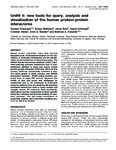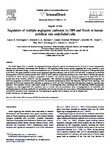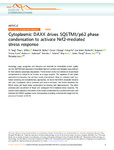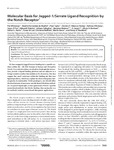UniHI 4: new tools for query, analysis and visualization of the human protein–protein interactome

Date
2009-01Author
Subject
Metadata
Show full item recordAbstract
Human protein interaction maps have become important tools of biomedical research for the elucidation of molecular mechanisms and the identification of new modulators of disease processes. The Unified Human Interactome database (UniHI, http://www.unihi.org) provides researchers with a comprehensive platform to query and access human protein-protein interaction (PPI) data. Since its first release, UniHI has considerably increased in size. The latest update of UniHI includes over 250,000 interactions between approximately 22,300 unique proteins collected from 14 major PPI sources. However, this wealth of data also poses new challenges for researchers due to the complexity of interaction networks retrieved from the database. We therefore developed several new tools to query, analyze and visualize human PPI networks. Most importantly, UniHI allows now the construction of tissue-specific interaction networks and focused querying of canonical pathways. This will enable researchers to target their analysis and to prioritize candidate proteins for follow-up studies.
Collections
Publisher
Place of Publication
Journal
Volume
Issue
Pagination
Recommended, similar items
The following license files are associated with this item:
Related items
Showing items related by title, author, creator and subject.
-
Regulation of multiple angiogenic pathways by Dll4 and Notch in human umbilical vein endothelial cells.
Harrington, LS; Sainson, RCA; Williams, CK; Taylor, JM; Shi, W; Li, J-L; Harris, AL (United States, 2008-03)The Notch ligand, Dll4, is essential for angiogenesis during embryonic vascular development and is involved in tumour angiogenesis. Several recent publications demonstrated that blockade of Dll4 signalling inhibits tumour ... -
Cytoplasmic DAXX drives SQSTM1/p62 phase condensation to activate Nrf2-mediated stress response
Yang, Y; Willis, TL; Button, RW; Strang, CJ; Fu, Y; Wen, X; Grayson, PRC; Evans, T; Sipthorpe, RJ; Roberts, SL; Hu, Bing; Zhang, J; Lu, B; Luo, Shouqing (Springer Science and Business Media LLCEngland, 2019-08-21)<jats:title>Abstract</jats:title><jats:p>Autophagy cargo recognition and clearance are essential for intracellular protein quality control. SQSTM1/p62 sequesters intracellular aberrant proteins and mediates cargo delivery ... -
Molecular basis for Jagged-1/Serrate ligand recognition by the Notch receptor.
Whiteman, P; de Madrid, BH; Taylor, P; Li, D; Heslop, R; Viticheep, N; Tan, JZ; Shimizu, H; Callaghan, J; Masiero, M; Li, JL; Banham, AH; Harris, AL; Lea, SM; Redfield, C; Baron, M; Handford, PA (United States, 2013-03-08)We have mapped a Jagged/Serrate-binding site to specific residues within the 12th EGF domain of human and Drosophila Notch. Two critical residues, involved in a hydrophobic interaction, provide a ligand-binding platform ...




